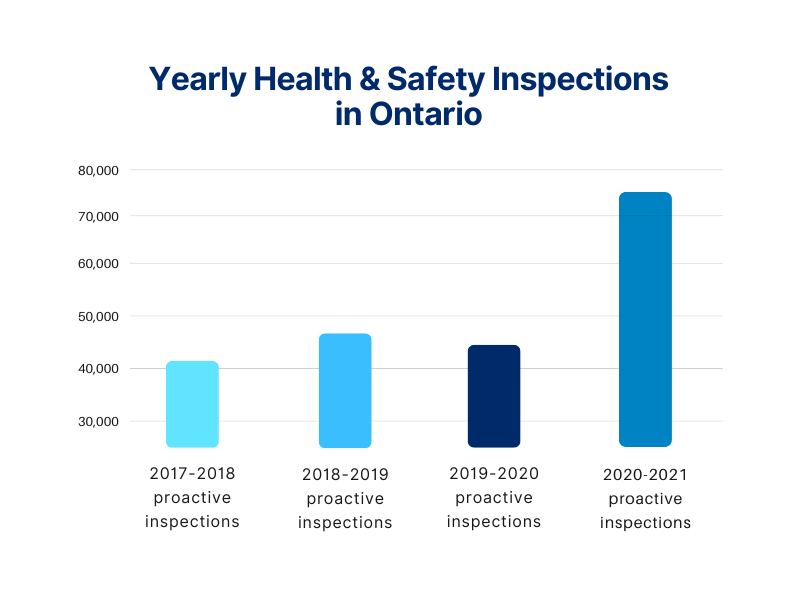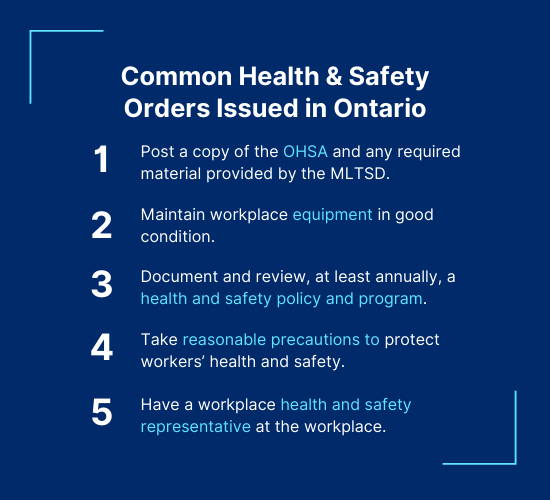A surprise visit from the Ministry of Labour, Immigration, Training and Skills Development (MLITSD) can be stressful, but inspections are an important part of keeping workplaces safe. The good news is that many employers feel much more confident once they know what to expect from an inspection and how to prepare for one.
What are inspectors looking for during an inspection?
If an inspector visits your workplace, they will be looking to ensure that employers are taking every reasonable precaution to keep employees safe and that workplaces are in compliance with the OHSA. During an inspection, an inspector may focus on a specific initiative such as occupational illness prevention as well as all workplace-specific hazards.
See the full 2025-2026 compliance initiative schedule.
Within the past few years, the MLITSD has increased unannounced, or proactive, workplace inspections by a significant amount compared to 2017, 2018, and 2019.

When auditing whether a workplace is compliant with the OHSA, an inspector might look for:
-
- Unsafe equipment or machinery such as damaged fall protection lifelines, missing bolts on forklift trucks, or loose rungs on ladders or scaffolding
- Fall hazards such as inadequate or missing guardrails, improper use of harnesses, slippery surfaces
- Safety Data Sheets (SDS) for all hazardous materials in the workplace
- Whether a supervisor is present to supervise work at all times
- A posted health and safety policy
- Posted emergency procedures
- Posted JHSC inspection records
- A posted workplace violence and harassment policy
- Health and safety at work and employment standards posters
- A copy of the OHSA (also known as the Green Book)
- Records of health and safety training
They may also request to see any of the following documents:
-
- Joint Health and Safety Committee (JHSC) meeting minutes
- Inspection reports
- Health and safety policies and procedures
- First-aid records
- Training records
- Hygiene test results
- Safety Data Sheets (SDSs)
- Accident/Incident reports
In July 2022, Bill 88: Working for Workers Act, 2022 (Working for Workers Act 2) came into effect which outlines new requirements for Ontario workplaces. Some of these new requirements include:
- Employers to provide a naloxone kit in workplaces where overdoses are a potential hazard.
- Employers with 25 or more employees must have a written policy on disconnecting from work.
See the full Working for Workers Act, 2022.
What should you do during an inspection?
The OHSA requires every person to assist an inspector during an inspection. It’s an offence to interfere in any way with an inspector. This includes giving false information or failing to give required information.
When an inspector arrives, they may ask to speak with a manager or a member of your JHSC.
To help the inspection go smoothly, you should:
-
- Answer the inspector’s questions honestly
- Provide any documentation an inspector requests to see and ask for a receipt listing all documents that they received
- Make sure managers and employees also understand that they should answer the inspector’s questions honestly and to the best of their abilities
- Assign a certified non-management member of your JHSC to accompany the inspector and employer during the inspection
Don’t be afraid to ask the inspector questions or for advice on certain topics during or after the inspection. Inspectors are often more than willing to share their expertise and refer you to relevant resources.
What happens if the inspector notices an issue?
If an inspector identifies a violation of the OHSA or regulations, they can issue ticket fines and an order for the employer to correct the violation.
There are two different types of orders:
-
- Compliance orders – an employer is given a specific time frame to comply with these orders. Examples of these types of orders would be developing a specific health and safety procedure, refreshing certain training certifications, or posting an up-to-date copy of the OHSA in the workplace.
- Stop work orders – if there is an immediate risk to employees’ health or safety, the inspector will order the employer to stop work until the hazard is addressed.

Depending on the violation, the inspector may issue tickets to the employer, supervisor, or employee. Offences that could result in a ticket include but are not limited to:
-
- An employer failing to ensure that employees have completed mandatory occupational health and safety awareness training and working at heights training
- An employer failing to select a health and safety representative or establish a JHSC
- An Employer failing to ensure there are guardrails or other fall protection equipment
- An employee failing to wear appropriate head, eye, or foot protection
- The failure to notify the Ministry of Labour about a project or certain kinds of construction work
- An employer failing to provide a naloxone kit in a workplace where workers are at risk of an opioid overdose.
The Ontario Court of Justice outlines the amounts for the full list of fines in the Set Fine Schedule. On-site tickets for OHSA violations generally range from $250 to $350 for workers, $450 to $550 for supervisors and $550 to $650 for employers. However, in July 2022 the new penalty provisions in came into effect, increasing maximum fines for directors or officers of a corporation from $100,000 to $1,500,000, and to $500,000 for other individuals.
What should you do if an order is issued?
If an order is issued, the first step is to comply with the order and notify the MTLSD within three days of doing so by completing the Notice of Compliance form. The inspector would have provided this form when they issued the order. The form must be:
-
- Signed by the employer
- Accompanied by a signed statement from a non-management member of the joint health and safety committee or a health and safety representative, indicating whether or not they agree that the employer has complied with the order
- Sent to inspector whose address will be on the form
A copy of the inspector’s order or report must be posted in the workplace where it is most likely to be seen by the employees. A second copy must be given to the Joint Health and Safety Committee or safety representative.
Any individual or entity who is affected by the order and feels it is incorrect can file an appeal through the Ontario Labour Relations Board (OLRB).
How to prepare for an inspection
Unannounced inspections don’t have to be stressful. Here are some tips to help you prepare for inspections and pass them with ease.
Perform a Gap Audit
Why wait for an MLITSD inspector to tell you whether or not your workplace is compliant? Finding and addressing any gaps in your current health and safety program help you pass MLITSD inspections when they happen.
Bringing in a third party is one of the most effective ways to do this. For example, a gap audit performed by a health and safety consultant can help you identify health and safety concerns and how to comply with health and safety legislation. Learn more about how you can create a safer workplace with a Gap Audit.
Ensure your JHSC is effective
Your JHSC is one of your most valuable resources when it comes to creating a safe workplace. Like MLITSD inspectors, their goal is to understand how potential hazards could affect employees and inform the employer of them.
To comply with the law and make sure your JHSC is fulfilling its purpose:
-
- Ensure your JHSC understands their health and safety responsibilities.
- Provide JHSC members with proper health and safety training.
- Listen to your JHSC’s recommendations.
- Encourage members to identify opportunities for improvement.
- Develop programs to address health and safety concerns your JHSC identifies.
Your JHSC should inspect your workplace at least monthly for hazards. If they identify a hazard, work with them to correct it. Learn about the key steps JHSC members should follow for an effective workplace inspection.
Make sure employees have the necessary training
A survey by MLITSD found that 24% of respondents reported having never received any form of occupational health and safety training. The health and safety training your employees are required to have will depend on their job function and your organization. An inspector may ask to see training records, so ensure you are keeping a record of all required training that your employees complete.
It’s also important to keep all training up to date because many certifications expire if refresher training isn’t completed after a certain time period.
-
- JHSC Refresher Training – Required every three years
- WHMIS Training – Review employees’ familiarity with training at least annually
- Working at Heights Refresher Training – Required every three years
- Safe Operation of Forklift Training – Must be refreshed every three years
The types of training that are required for your employees will depend on their job function and your organization. The OHSA does not specify how often every type of safety training must be completed. If unspecified, the best practice is to refresh your employees’ training at least every three years. If your employees need to update their training, you can check out our calendar for a list of upcoming courses.
Learn about the 4 topics Ontario employers must provide training on.
Regularly review and update your health and safety program
In Ontario, every workplace must have a documented health and safety program. Your program sets out your plan for creating a safe workplace. Programs will vary by workplace, but some items included in a health and safety program are:
-
- Employee training (e.g., new workers, WHMIS, new job procedures)
- Workplace inspections and hazard analysis
- Health and safety responsibilities of everyone in the workplace
- Analysis of the accidents and illnesses occurring at the workplace
- A health and safety budget
- A plan to assess working conditions, including periodic inspections
- A process to address health and safety concerns of employees
- A plan for required personal protective equipment maintenance
- Emergency, first aid and rescue procedures
- Fire prevention
Please note that this is not a comprehensive list of program elements.
Under the OHSA, you must review and make any necessary updates to your program at least once a year. Make sure you include your JHSC when reviewing your program and consider:
-
- What areas of your program are working well and what needs improvement?
- What are changes that need to be made to stay compliant?
Develop an inspection checklist and use it regularly
A checklist will help ensure nothing gets missed during monthly JHSC inspections. Thorough and regular JHSC inspections will help keep your workplace safe. You’ll also be able to identify and correct any health and safety issues and instead of discovering them during an unannounced MLITSD inspection.
The best checklist is one that you have developed to suit the needs of your organization. It should be customized to address specific items and areas in your workplace. Use our template as a starting point to create your inspection checklist.
Download your free health and safety inspection checklist.
Fill out the form below to get instant access to a sample workplace inspection checklist.